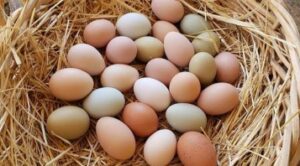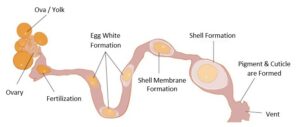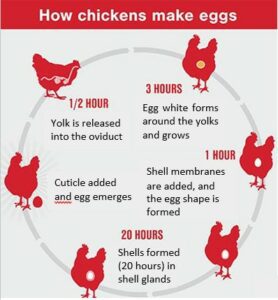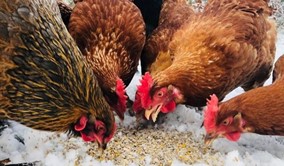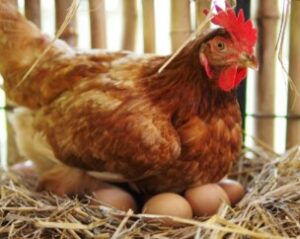
As the days get shorter, egg production starts to decline. Hens need a certain amount of daylight in order to maintain peak egg-laying. A hen’s reproductive cycle is controlled by photoperiod, or light exposure. Hens require at least 14 hours of light per day to lay eggs. Chickens produce eggs at a maximum rate with 16 hours of light exposure. Once daylight is less than 12 hours, egg production slows down considerably if not ceasing completely. The hen’s pineal gland produces melatonin, which helps regulate sleep and other body functions. As the days lengthen, her pineal gland responds by sending a hormone through her body to her ovary to start producing eggs. As the days shorten, the pineal gland stops sending this hormone. Since the gland is light- sensitive, you can fool it by increasing the amount of light available to the hen during the fall and winter. To fool the pineal gland, you can use artificial light. Use incandescent bulbs rather than fluorescent lights, as the wavelengths of incandescent bulbs are closer to those of natural sunlight. Put the bulb on a timer so it goes on in the dark hours of the morning rather than at nighttime. Set the timer so that hens have only eight hours of darkness. For example, if the sun sets at 5PM, set the timer so that the light goes on at 8AM.
A laying hen’s ovary holds thousands of tiny ova, or future egg yolks. Birds are unique among animals because only one ovary (the left) matures to the stage where it releases eggs. When a yolk is ready, it moves out of the ovary an d into the oviduct – a tube- like structure that is divided into different sections. Over four hours, the yolk moves through an area of the oviduct called the magnum where egg white protein is added to it. There are many different proteins that make up the egg white. The different protein layers provide protection for the yolk and create a template for the formation of the shell membrane and shell. After quickly moving through a section called the isthmus where shell membrane fibers are produced, the egg enters the shell gland where the shell forms over about 20 hours. The process is called calcification as layers of calcium carbonate are added to form the shell. During the last two hours of shell formation the bulk of the pigment (white or brown) is produced and deposited into the outer layer of the shell. This includes the cuticle which is laid down to provide protection against bacteria that might try to penetrate the shell and potential loss of water from the egg contents. The egg then rotates just before the laying to be laid large end first, having moved through the oviduct small end first.
Product of the Week: “O” Poultry Premix
“O” Poultry Premix is a complete vitamin and mineral premix package designed to meet the specific nutritional needs of poultry.
- Contains sulfate forms of trace
- Meets daily vitamin needs, including vitamins A, D3, E, and B complex.
- Supplies most major mineral nutrients – calcium, phosphorus, sodium, and chloride.

